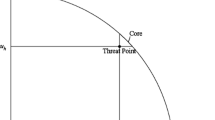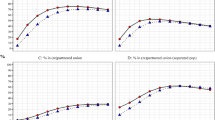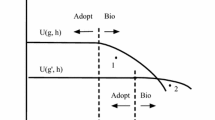Abstract
This paper presents an overlapping generations household model with positive assortative matching (richer individuals marry richer partners), incomplete information about partner’s type (it takes time to reveal income-earning capabilities of individuals) and a gender pay gap on the labor market (men are more likely to end up with a high-paying job). In equilibrium, a gender pay gap creates an excess supply of desirable husbands and women marry early to increase their chance of being matched with an ideal partner, which results in a gender age gap on the marriage market. A modified model with asymmetric information yields a similar result. An extended model where individuals have an option to remain single (the marriage market does not necessarily clear in equilibrium) yields a similar result as well.


Similar content being viewed by others
Notes
In this paper we do not make a distinction between a registered civil (or religious) marriage and a common law marriage (or de facto partnership).
That is, everyone evaluates a compound lottery via its corresponding reduced-form simple lottery.
That is, everyone prefers lotteries yielding a higher probability of a match with the most preferred partner.
Starmer (2000, Sect. 3, pp. 336-339) summarizes descriptive limitations of expected utility theory. Some behavioral regularities that falsify expected utility theory are the Allais (1953) paradox, also known as the common consequence effect, or the reverse thereof (e.g., Starmer 1992; Blavatskyy 2013); the common ratio effect (e.g., Kahneman and Tversky 1979) or the reverse thereof (e.g., Blavatskyy 2010).
When all women decide to marry in the first period and only a fraction m∊[0,1) of men decide to do so, a woman who postpones her marriage till the second period is matched with her ideal partner with probability q; a woman who decides to marry in the first period is matched with a man who revealed a high type with an ex ante probability (1 − m)p and with a man who did not reveal his type—with probability m. Thus, a marriage in the first period is equivalent to a lottery that yields an ideal partner with probability (1 − m)p + mp = p>q. In other words, women have no incentive to deviate from their equilibrium strategy by postponing their marriage.
If a woman enters the marriage market in the second period, she reveals a high type with probability q, in which case she is matched with a partner who has not revealed his type, and she reveals a low type—with probability 1 − q, in which case she remains unmarried. Thus, the strategy of entering the marriage market in the first period (first-order) stochastically dominates the strategy of entering the marriage market in the second period when \( q < F\left( q \right)/F\left( p \right) \).
Carbone and Hey (1995), Loomes and Sugden (1998, Table 2, p. 591) and Hey (2001, Table 2, p. 14) found that stochastic dominance was violated correspondingly in 1 out of 320 cases (0.3%), 13 out of 920 cases (1.4%) and 24 out of 1590 cases (1.5%). Tversky and Kahneman (1986, p. 264), however, found that stochastic dominance was violated in 72 out of 124 cases (58%) when the dominance relation was not transparent.
And he is matched a woman who revealed a low type with probability 1 − p.
And he is matched a woman who revealed a low type with probability \( \frac{{m - \left( {1 - f} \right)q + \left( {1 - m} \right)p - f}}{m} \).
References
Allais, M. (1953). Le comportement de l’homme rationnel devant le risque: Critique des postulates et axiomes de l’Ecole Américaine. Econometrica, 21, 503–546.
Bergstrom, T., & Bagnoli, M. (1993). Courtship as a waiting game. Journal of Political Economy, 101(1), 185–202.
Blau, F. D., & Kahn, L. M. (2006). The US gender pay gap in the 1990s: Slowing convergence. Industrial and Labor Relations Review, 60(1), 45–66.
Blau, F. D., & Kahn, L. M. (2007). The gender pay gap: Have women gone as far as they can? Academy of Management Perspectives, 21(1), 7–23.
Blavatskyy, P. (2010). Reverse common ratio effect. Journal of Risk and Uncertainty, 40, 219–241.
Blavatskyy, P. (2013). Reverse Allais paradox. Economics Letters, 119(1), 60–64.
Carbone, E., & Hey, J. (1995). A comparison of the estimates of EU and non-EU preference functionals using data from pairwise choice and complete ranking experiments. Geneva Papers on Risk and Insurance Theory, 20, 111–133.
Danziger, L., & Neuman, Sh. (1999). On the age at marriage: Theory and evidence from Jews and Moslems in Israel. Journal of Economic Behavior and Organization, 40, 179–193.
Elul, R., Silva-Reus, J., & Volij, O. (2002). Will you marry me? A perspective on the gender gap. Journal of Economic Behavior and Organization, 49, 549–572.
Hey, J. (2001). Does repetition improve consistency? Experimental Economics, 4, 5–54.
Kahneman, D., & Tversky, A. (1979). Prospect theory: An analysis of decision under risk. Econometrica, XLVII, 263–291.
Keeley, M. (1979). On analysis of the age pattern of first marriage. International Economic Review, 20(2), 527–544.
Loomes, G., & Sugden, R. (1998). Testing different stochastic specifications of risky choice. Economica, 65, 581–598.
Polachek, S. & Xiang, J. (2014). The gender pay gap across countries: A Human Capital Approach. IZA Discussion Paper No. 8603.
Roth, M. T. (1987). Age at marriage and the household: A study of Neo-Babylonian and Neo-Assyrian forms. Comparative Studies in Society and History, 29, 715–747.
Saller, R. (1987). Men’s age at marriage and its consequences in the roman family. Classical Philology, 82, 21.
Shaw, B. (1987). The age of Roman girls at marriage: Some reconsiderations. Journal of Roman Studies, 77, 30–46.
Starmer, C. (1992). Testing new theories of choice under uncertainty using the common consequence effect. The Review of Economic Studies, 59(4), 813–830.
Starmer, C. (2000). Developments in non-expected utility theory: The hunt for a descriptive theory of choice under risk. Journal of Economic Literature, 38, 332–382.
Tversky, A., & Kahneman, D. (1986). Rational choice and the framing of decisions. Journal of Business, 59(4), 251–278.
UN. (1990). Patterns of first marriage: Timing and prevalence. New York: United Nations Department of International Economic and Social affairs.
Weichselbaumer, D., & Winter-Ebmer, R. (2005). A meta-analysis on the international gender wage gap. Journal of Economic Surveys, 19(3), 479–511.
Zhang, J. (1995). Do men with higher wages marry earlier or later? Economics Letters, 49, 193–196.
Author information
Authors and Affiliations
Corresponding author
Additional information
I am grateful to the coordinating editor, two anonymous reviewers, Joro Kolev, Patrick Leoni, Andreas Ortmann and Vernon Smith for helpful comments.
Appendix
Appendix
Proof of proposition 1.
Step 1 We prove that there cannot be an equilibrium when \( \left( {1 - f} \right)q \ge \left( {1 - m} \right)p \).
In this case, there is an excess supply \( \left( {1 - f} \right)q - \left( {1 - m} \right)p \ge 0 \) of women who revealed a high type in the second period. Inequality \( \left( {1 - f} \right)q \ge \left( {1 - m} \right)p \) implies inequality \( m - \left( {1 - f} \right)q + \left( {1 - m} \right)p \ge f \) so that we have an excess supply of unmatched men who did not reveal their type (over women who did not reveal their type). Thus, every woman who revealed a high type is matched either with a man who revealed a high type as well, or—with a man who has not yet revealed his type. Additionally, every woman who has not yet revealed her type is matched with a man who has not yet revealed his type.
In this case, a man who decides to enter the marriage market in the second period is matched with a woman who revealed a high type with an ex ante probability p.Footnote 9 On the other hand, a man who decides to enter the marriage market in the first period is matched with a woman who revealed a high type with probability
and with a woman who has not yet revealed her type—with probability f/m.Footnote 10 In other words, the strategy of entering the marriage market in the first period is equivalent to a simple lottery that yields a match with a woman who revealed a high type with probability:
and a match with a woman who revealed a low type with probability \( 1 - r \).
Thus, for men, the strategy of entering the marriage market in the second period (first-order) stochastically dominates the strategy of entering the marriage market in the first period. This implies that m must be zero, in which case inequality \( \left( {1 - f} \right)q \ge \left( {1 - m} \right)p \) cannot hold for any f∊[0,1]. Hence, in any equilibrium we must have \( \left( {1 - m} \right)p > \left( {1 - f} \right)q \).
Step 2 We prove that there cannot be an equilibrium when \( \left( {1 - m} \right)p > \left( {1 - f} \right)q \) and \( f - \left( {1 - m} \right)p + \left( {1 - f} \right)q < m \).
In case when \( \left( {1 - m} \right)p > \left( {1 - f} \right)q \) we have an excess supply \( \left( {1 - m} \right)p - \left( {1 - f} \right)q > 0 \) of men who revealed a high type in the second period. Moreover, when \( f - \left( {1 - m} \right)p + \left( {1 - f} \right)q < m \) we also have an excess supply of men who did not reveal their type (over unmatched women who did not reveal their type). Thus, a woman who decides to enter the marriage market in the second period is matched with a man who revealed a high type with probability q, with a man who has not yet revealed his type—with probability
and with a man who revealed a low type—with the remaining probability \( 1 - q - s \). In other words, the strategy of entering the marriage market in the second period is equivalent to a simple lottery that yields a match with a man who revealed a high type with probability \( q + sp \) and a match with a man who revealed a low type with probability \( 1 - q - sp \).
On the other hand, a woman who decides to enter the marriage market in the first period is matched with a man who revealed a high type with probability:
and with a man who has not yet revealed his type—with the remaining probability \( 1 - t \). In other words, the strategy of entering the marriage market in the first period is equivalent to a simple lottery that yields a match with a man who revealed a high type with probability \( t + \left( {1 - t} \right)p \) and a match with a man who revealed a low type with probability \( 1 - t - \left( {1 - t} \right)p \).
A simple algebra yields \( t + \left( {1 - t} \right)p > q + sp \), i.e., for women, the strategy of marrying in the first period (first-order) stochastically dominates the strategy of marrying in the second period. This implies that f must be one, in which case inequality \( f - \left( {1 - m} \right)p + \left( {1 - f} \right)q < m \) cannot hold for any m∊[0,1].
Step 3 We prove that f = 1 in equilibrium.
Results from steps 1 and 2 imply that an equilibrium can exist only when \( \left( {1 - m} \right)p > \left( {1 - f} \right)q \) and \( f - \left( {1 - m} \right)p + \left( {1 - f} \right)q \ge m \). Thus, in equilibrium we must have an excess supply \( \left( {1 - m} \right)p - \left( {1 - f} \right)q > 0 \) of men who revealed a high type in the second period (over women who revealed a high type) and an excess supply \( f - \left( {1 - m} \right)p + \left( {1 - f} \right)q - m \ge 0 \) of unmatched women who did not reveal their type (over men who did not reveal their type). In this case, a woman who decides to enter the marriage market in the second period is matched with a man who revealed a high type with probability q and with a man who revealed a low type—with probability \( 1 - q \).
On the other hand, a woman who decides to enter the marriage market in the first period is matched with a man who revealed a high type with probability t, with a man who has not yet revealed his type—with probability m/f and with a man who revealed a low type—with the remaining probability \( 1 - t - m/f \). In other words, the strategy of entering the marriage market in the first period is equivalent to a simple lottery that yields a match with a man who revealed a high type with probability:
and a match with a man who revealed a low type with probability \( 1 - t - mp/f \). Therefore, for women, the strategy of marrying in the first period (first-order) stochastically dominates the strategy of marrying in the second period. This implies that f must be one in equilibrium.
When all women enter the marriage market already in the first period, men are exactly indifferent between entering the marriage market in the first or the second period (in both cases they are matched for sure with a partner who has not yet revealed her type). Thus, the only pure strategy equilibrium on the marriage market is given by f = 1 and m∊[0,1]. □
Rights and permissions
About this article
Cite this article
Blavatskyy, P. Why do young women marry old men?. Theory Decis 85, 509–525 (2018). https://doi.org/10.1007/s11238-018-9662-z
Published:
Issue Date:
DOI: https://doi.org/10.1007/s11238-018-9662-z




